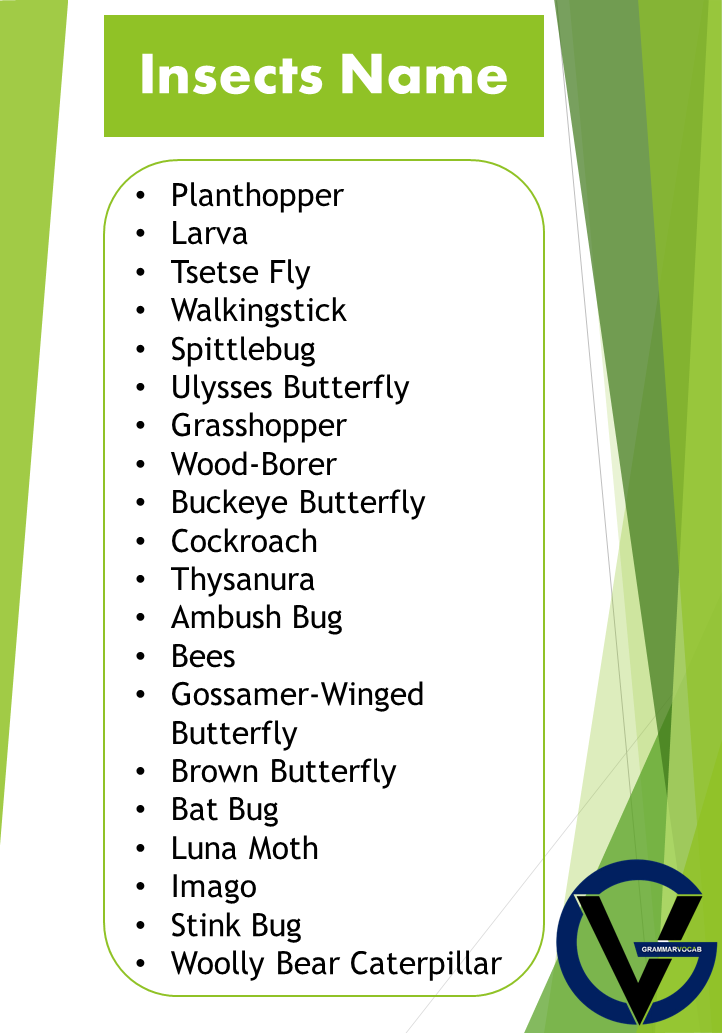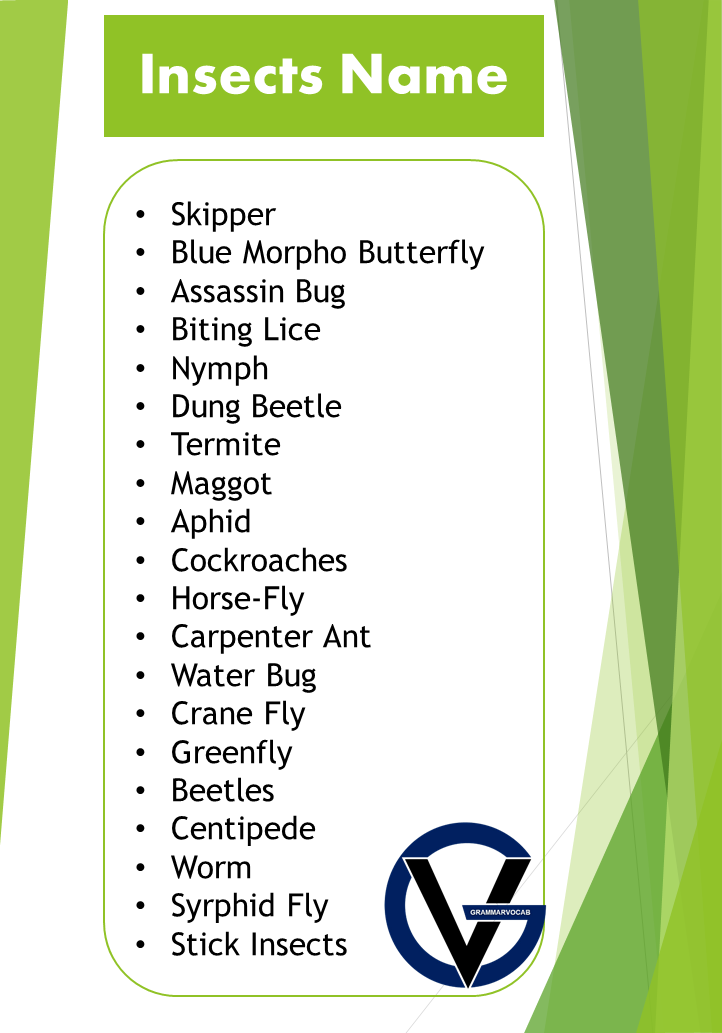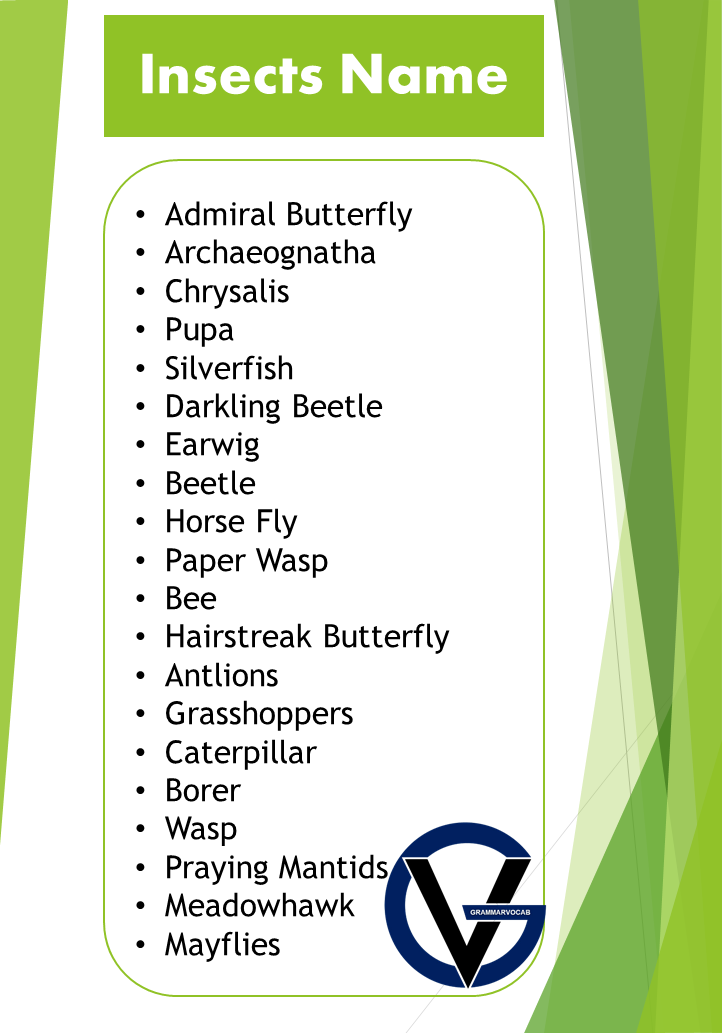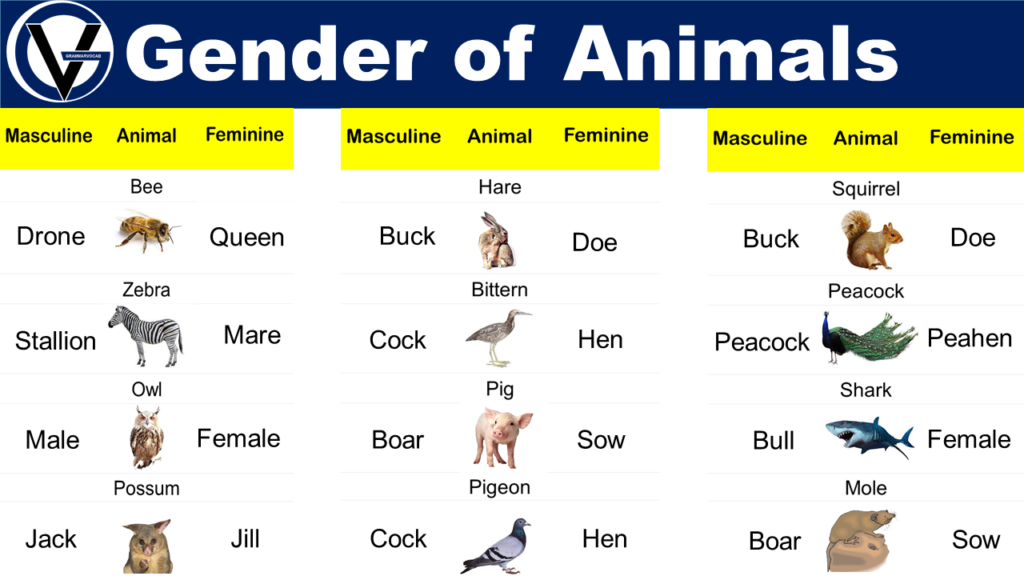Insects are the most diverse group of animals on Earth, with an estimated 5.5 million species. They can be found in virtually every habitat, from the deepest oceans to the highest mountains, and they play a vital role in the ecosystems they inhabit. From colorful butterflies to buzzing bees, insects are fascinating creatures that capture our imagination and curiosity. In this blog post, we have compiled a comprehensive list of insect names, ranging from the common to the obscure, to help you learn more about these incredible creatures.
List Of All Insects Names
- Midge
- Metamorphosis
- Fire AntAll
- Damselfly
- Fleas
- Fly
- Zebra Swallowtail Butterfly
- Cockchafer
- Stag Beetle
- Spider
- Pond Skater
- Dragonflies
- Web-Spinners
- Praying Mantis
- Locust
- Katydid
- Gypsy Moth
- Dobsonflies
- Plant Bug
- Cicada
- Flea
- Caddisflies
- Copper Butterfly
- Bug
- Moth
- Dragonfly
- Monarch
- Wood Nymph Butterfly
- Tiger Beetle
- Lace Bug
- Snail
- Praying Mantid
- House Fly
- Mayfly
- Butterfly
- Crickets
- Mantid
- Stonefly
- Scorpionflies
- True Bugs
- Planthopper
- Larva
- Tsetse Fly
- Walkingstick
- Spittlebug
- Ulysses Butterfly
- Grasshopper
- Wood-Borer
- Buckeye Butterfly
- Cockroach
- Thysanura
- Ambush Bug
- Bees

Must Learn: Different Species Of Fish
Insects Name List
- Gossamer-Winged Butterfly
- Brown Butterfly
- Bat Bug
- Luna Moth
- Imago
- Stink Bug
- Woolly Bear Caterpillar
- Skipper
- Blue Morpho Butterfly
- Assassin Bug
- Biting Lice
- Nymph
- Dung Beetle
- Termite
- Maggot
- Aphid
- Cockroaches
- Horse-Fly
- Carpenter Ant
- Water Bug
- Crane Fly
- Greenfly
- Beetles
- Centipede
- Worm
- Syrphid Fly
- Stick Insects
- Admiral Butterfly
- Archaeognatha
- Chrysalis
- Pupa
- Silverfish
- Darkling Beetle
- Earwig
- Beetle
- Horse Fly
- Paper Wasp
- Bee
- Hairstreak Butterfly
- Antlions
- Grasshoppers
- Caterpillar
- Borer
- Wasp
- Praying Mantids
- Meadowhawk
- Mayflies
Names of Insects Groups
Here is a list of some of the major groups or orders of insects:
- Coleoptera (beetles)
- Diptera (flies)
- Hymenoptera (ants, bees, wasps)
- Lepidoptera (moths and butterflies)
- Hemiptera (true bugs)
- Orthoptera (grasshoppers, crickets, and katydids)
- Odonata (dragonflies and damselflies)
- Phasmida (stick insects)
- Blattodea (cockroaches)
- Isoptera (termites)
- Mantodea (praying mantises)
- Neuroptera (lacewings)
- Dermaptera (earwigs)
- Siphonaptera (fleas)
- Thysanoptera (thrips)
- Trichoptera (caddisflies)
- Psocoptera (booklice)
- Phthiraptera (lice)
- Ephemeroptera (mayflies)
- Collembola (springtails)
- Mecoptera (scorpionflies)
- Strepsiptera (twisted-wing parasites)
- Megaloptera (alderflies and dobsonflies)
- Raphidioptera (snakeflies)
- Coleorrhyncha (moss bugs)
- Thysanura (silverfish)
- Embioptera (webspinners)
- Zoraptera (angel insects)
- Grylloblattodea (rock crawlers)
- Plecoptera (stoneflies)
- Phasmatodea (leaf insects)
- Mantophasmatodea (gladiators)
- Ephemeroptera (mayflies)
- Megaloptera (dobsonflies and alderflies)
- Mecoptera (scorpionflies and hangingflies)
- Neuroptera (antlions, lacewings, and owlflies)
- Raphidioptera (snakeflies)
- Siphonaptera (fleas)
- Zygentoma (silverfish and firebrats)
- Protura (proturans)
Scientific Names of Insects
| Insects Names | Scientific Names |
| Honey bee | Apis mellifera |
| Monarch butterfly | Danaus plexippus |
| Ladybug | Coccinella septempunctata |
| Housefly | Musca domestica |
| Mosquito | Aedes aegypti |
| Fruit fly | Drosophila melanogaster |
| Grasshopper | Melanoplus bivittatus |
| Cockroach | Periplaneta americana |
| Fire ant | Solenopsis invicta |
| Western honey bee | Apis mellifera |
| Yellow jacket | Vespula vulgaris |
| Japanese beetle | Popillia japonica |
| Luna moth | Actias luna |
| Praying mantis | Mantis religiosa |
| Cabbage butterfly | Pieris rapae |
| Black widow spider | Latrodectus mactans |
| Cicada | Magicicada septendecim |
| Stick insect | Phasmida |
| Termite | Isoptera |
| Assassin bug | Reduvius personatus |
| Green lacewing | Chrysoperla carnea |
| Colorado potato beetle | Leptinotarsa decemlineata |
| Oriental cockroach | Blatta orientalis |
| Tiger mosquito | Aedes albopictus |
| Japanese hornet | Vespa mandarinia |
| Carpenter bee | Xylocopa virginica |
| Desert locust | Schistocerca gregaria |
| European honey bee | Apis mellifera |
| Black fly | Simulium spp. |
| Brown marmorated stink bug | Halyomorpha halys |
| Assassin bug | Zelus renardii |
| Silverfish | Lepisma saccharina |
| Blowfly | Calliphora vomitoria |
| Hercules beetle | Dynastes hercules |
| Yellow fever mosquito | Aedes aegypti |
| Leafhopper | Cicadellidae |
| Jewel beetle | Chrysochroa fulgidissima |
| Red imported fire ant | Solenopsis invicta |
| Luna moth | Actias luna |
| Spotted lanternfly | Lycorma delicatula |
| Boll weevil | Anthonomus grandis |
| Stonefly | Plecoptera |
| Tobacco hornworm | Manduca sexta |
| Mud dauber wasp | Sceliphron caementarium |
| Giant water bug | Lethocerus americanus |
| Armyworm | Mythimna unipuncta |
| House cricket | Acheta domesticus |
| Eastern tent caterpillar | Malacosoma americanum |
| Southern green stink bug | Nezara viridula |
| Blue morpho butterfly | Morpho peleides |
People also ask (FAQs)
What insects have 6 wings?
Insects that have six wings belong to the order of insects called “Diptera.” These insects are commonly known as flies, and they are easily recognizable by their two large wings in the front and two smaller wings in the back, which evolved into small, knob-like structures called halteres that help with balance and flight stability.
There are, however, some insects that have six functional wings, and they belong to the order “Hymenoptera.” This includes bees, wasps, and ants, which have two pairs of membranous wings, with the front pair being larger than the back pair. The two pairs of wings are linked by tiny hooks called hamuli, which allow the wings to work together during flight.
What is the most beautiful insect?
Beauty is subjective and can vary from person to person, so it’s challenging to determine the “most beautiful” insect. However, some insects are often regarded as beautiful due to their vibrant colors, intricate patterns, and unique shapes. Here are a few examples:
Morpho butterfly: The Morpho butterfly is known for its stunning, iridescent blue wings that shine in the sunlight.
Orchid mantis: The Orchid mantis is a master of disguise, with its petal-like legs and bright pink or white coloring, it looks like a flower.
Peacock spider: The male peacock spider is tiny but packs a punch with its beautiful, iridescent body and its courtship dance that involves waving its colorful abdomen.
Jewel beetle: Jewel beetles have a shiny, metallic appearance that gives them an appearance of wearing gems or jewels.
Luna moth: The Luna moth is a beautiful green moth with long, curvy tails on its hindwings, making it a favorite among many insect enthusiasts.
Of course, there are many other insects that could be considered beautiful, so it really comes down to personal preference.
What are 6 legs insect names?
The vast majority of insects have six legs, which is a defining characteristic of the class Insecta. Here are some examples of insects with six legs:
- Ants
- Bees
- Beetles
- Butterflies
- Cockroaches
- Grasshoppers
- Ladybugs
- Mosquitoes
- Moths
Spiders (technically arachnids, but often included with insects)
There are many other insects with six legs, including some that are less well-known or more specialized. But these examples represent a diverse range of orders and families within the class Insecta.
Which insect is powerful?
Insects may be small, but they can be incredibly powerful in many ways. Here are a few examples of insects that are known for their impressive strength:
Rhinoceros beetle: The Rhinoceros beetle is one of the strongest insects on Earth, capable of lifting objects over 850 times its body weight. Male beetles use their horns to battle other males for mating rights, making them some of the strongest insects in terms of sheer force as well.
Leafcutter ant: Leafcutter ants are tiny but incredibly strong. They are capable of carrying objects up to 50 times their own weight, and they work together to cut and transport leaves and other materials to their nests.
Hercules beetle: The Hercules beetle is another strong beetle species, capable of lifting objects up to 850 times its own weight.
Praying mantis: Praying mantises are known for their strength and agility, capable of capturing and killing prey much larger than themselves. They have strong, sharp front legs that they use to grab and hold onto prey while they eat.
Dung beetle: Dung beetles may not look like powerhouses, but they are incredibly strong for their size. They are capable of rolling balls of dung that are many times their own weight, sometimes up to 50 times their own body weight.
These are just a few examples of insects with impressive strength, but there are many other insects that could be considered powerful in various ways.
What are the smallest insects?
The smallest insects are often microscopic in size and can be challenging to see without a microscope. Here are some examples of the smallest insects:
Fairyflies: Fairyflies are tiny parasitic wasps that are typically less than 1mm in length. They are some of the smallest insects on Earth and are barely visible to the naked eye.
Beetles of the family Ptiliidae: Many species of beetles in the family Ptiliidae are among the smallest insects, with adults often measuring less than 1mm in length.
Parasitic wasps of the family Mymaridae: Many species of parasitic wasps in the family Mymaridae are incredibly small, with adults measuring less than 0.2mm in length.
Thrips: Thrips are tiny insects that typically measure less than 2mm in length. They are often found on flowers and plants and can be a pest in agriculture.
Springtails: Springtails are tiny, wingless insects that are usually less than 6mm in length. They are often found in soil or leaf litter and play an essential role in soil ecology.
There are many other tiny insects, but these are just a few examples of some of the smallest.
Download List of Insects Name PDF







